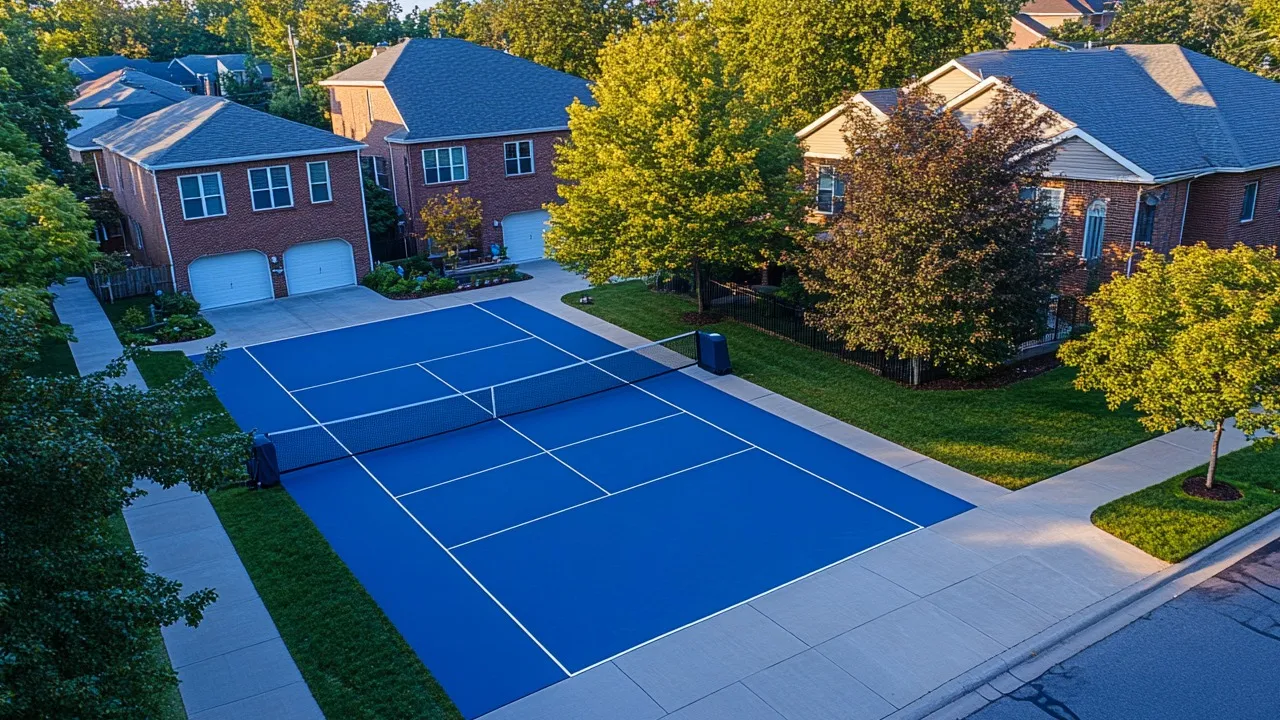How to Turn Your Driveway into a Portable Pickleball Court
Transforming your driveway into a portable pickleball court for driveway games is easier than you might think. Whether you’re hosting weekend matches with friends, practicing your dink shots solo, or laying the foundation for a neighborhood pickleball league, a temporary pickleball court setup turns ordinary concrete into an action-packed arena. In this guide, we’ll read no surface-level advice here into each step, tool, and technique you need to build a reliable, safe, and hack-proof portable court.
Why a Driveway Court?
Convenience Meets Performance
You’ve got a flat, hard surface you drive on every day. Why not drive up your pickleball game there? Using your driveway means:
- High coefficient of friction (read: great grip) compared to grass or sand.
- Minimal substrate prep—no need to level sand or lay down turf.
- Easy access to power outlets for portable lighting or streaming cameras.
Cost-Effective and Low-Commitment
Installing a permanent court can run into thousands. A portable version:
- Keeps your HOA happy—no permanent lines or drilling.
- Fits seasonal use—teardown before harsh weather, reclaim the space for parking.
- Scales budgets—modular tile systems let you add or remove sections over time.
Planning and Measurements
Dimensions & Layout
A regulation pickleball court footprint is 20 ft (width) × 44 ft (length). On a driveway:
- Measure your available space: Grab a tape measure (or laser measure) and mark the maximum nontapering rectangle.
- Allow buffer zones: Leave at least 2–3 ft behind baselines and sidelines for player safety.
- Court orientation: Ideally, align the court north-south to minimize sun glare during morning/evening play.
Choosing the Right Portable Court Materials
Interlocking Modular Tiles
Industry term: Snap-together polypropylene court tiles.
Pros:
- Quick assembly—click and lock in under an hour.
- Shock absorption built into the core, reducing joint impact.
- UV-stabilized for outdoor durability.
Cons:
- Higher upfront cost per square foot.
- Edges may need transition strips to prevent tripping.
Key specs:
- Surface CoF (Coefficient of Friction): 0.6–0.8 (ideal range).
- Tile thickness: 10–15 mm for balanced shock absorption.
Court Marking Tape vs. Paint
For a temporary pickleball court setup, avoid paint. Use:
- Durable court tape: PVC-backed, adhesive designed for concrete, removable without residue.
- Peel-and-stick sport line tape: Comes in regulation widths (2 in) and bright colors for contrast.
Pro tip: Clean the surface with isopropyl alcohol before taping for maximum adhesion.
Portable Nets & Posts
Opt for telescopic powder-coated steel posts with rubber base anchors. Look for:
- Height adjustability (36 in at sidelines, 34 in center).
- Quick-release clamps for net tension.
- Weighted base or sandbags to keep posts stable on concrete.
Surface Preparation: The Substrate Check
- Cleanliness is king: Sweep and power wash to eliminate debris, oil spots, or mildew.
- Seal cracks: Use a concrete filler to smooth hairline fractures—prevent tile stress points.
- Non-permanent leveling: For mild dips, self-leveling polymer compound can fill low spots by ½ in or less.
Assembling the Portable Court
Laying the Foundation
- Start at the baseline: Lay a straight row of tiles, aligning edges snugly.
- Work outward: Build in a grid pattern, using spacers to maintain straight lines.
- Edge trim: Snap on transition strips to create safe perimeters.
Line Marking
- Apply sport line tape along the joints or directly onto tiles.
- Press firmly with a roller for a flush seal.
- Smooth out bubbles and cut tape at corners with a utility knife.
Installing the Net System
- Position posts in pre-designated holes (or use weighted bases).
- Clip in the net, adjusting tension so it’s taut but not overstretched.
- Confirm net height with a tape measure at key points.
Accessories & Enhancements
Lighting Solutions
- Portable LED floodlights on tripods: 1,500–3,000 lumens per light.
- Battery-powered string lights: For soft ambient glow during casual play.
Ball Containment & Storage
- Portable ball tubes attach to fence or post—keeps Spalding balls at hand.
- Foldable ball hopper for quick pickup during training drills.
Scorekeeping & Coaching Aids
- Magnetic scoreboards: Stick to metal posts.
- Shot placement cones: Place 2 ft inside baseline for serving drills.
Maintenance, Teardown, and Storage
Maintenance Tips
- After each session, wipe tiles with mild soap solution to remove scuff marks.
- Inspect tape lines weekly; replace any peeling sections.
- Check net tension and post stability monthly.
Teardown Process
- Remove line tape and store flat—roll without folds to prevent creases.
- Unlock tiles in reverse order—stack in labeled bundles for quick redeployment.
- Pack net, posts, and accessories in a durable duffel bag or hard-case trolley.
Storage Considerations
- Store tiles in a climate-controlled area to prevent warping.
- Keep tapes and small accessories in clear, zippered pouches.
- Label everything: Baseline bundles, sideline bundles, accessories kit, etc.
Safety and Best Practices
- Personal protective gear: Wear non-marking court shoes with good outsole traction.
- Edge awareness: Use transition strips of contrasting colors to highlight court boundaries.
- Weather watch: Don’t play on wet tiles—slip hazard due to hydroplaning.
Tips & Tricks from the Pros
- Court rotation: Swap tiles corner-to-corner every year to equalize wear patterns.
- Heat management: On hot days, mist tiles lightly with water to cool the surface.
- Custom logos: Use vinyl decals under clear modular tiles to personalize your court.
Conclusion
Turning your driveway into a portable pickleball court is an investment in accessibility, fun, and fitness. By following this in-depth guide measuring precise footprints, choosing high-performance materials, prepping your substrate, and mastering installation and teardown, you’ll have a professional-grade, temporary pickleball court setup in no time.
So roll up those sleeves, gather your gear, and get ready to serve, volley, and spike right in your driveway. Your neighbors might start asking for game times—get ready to become the local pickleball hero!
FAQs
Q1. Can I really set up a pickleball court on my driveway?
Yes! With the right materials and a little planning, your driveway can become a regulation-size, temporary pickleball court perfect for casual play or competitive practice.
Q2. What size should my driveway be for a pickleball court?
A standard pickleball court measures 20 ft × 44 ft. Ideally, your driveway should accommodate this plus 2–3 ft buffer zones around all sides for safety.
Q3. What kind of surface works best for a driveway court?
Concrete is ideal due to its flatness and high friction. Make sure it’s clean, sealed, and free of cracks for best results.
Q4. Do I need to paint lines on the driveway?
No. Use durable court tape designed for concrete. It’s easy to apply, removable, and won’t damage your driveway.
Q5. What are modular court tiles and are they necessary?
Modular tiles are interlocking polypropylene panels that create a professional playing surface. They’re optional but recommended for shock absorption and improved traction.
Q6. How do I set up the pickleball net system?
Use a portable net system with telescoping steel posts and a weighted or anchored base. Ensure the net height is 36 inches at sidelines and 34 inches at center.
Q7. How long does it take to assemble and disassemble the court?
With practice, setup and teardown can take under an hour. Tiles snap together quickly, and tape lines are easy to lay down and remove.
Q8. Can I play in the evening or at night?
Yes, use portable LED floodlights or battery string lights to illuminate the court safely for nighttime games.
Q9. Is the setup weather-resistant?
Modular tiles and portable nets are generally weather-resistant. However, avoid playing on wet surfaces and store materials indoors during extreme weather to prevent damage.
Q10. How should I store everything after use?
Disassemble tiles and stack in labeled bundles. Store net, posts, and accessories in a duffel bag or hard case in a climate-controlled area to avoid warping or corrosion.
COMMENTS
Sort by :





Leave A Comment